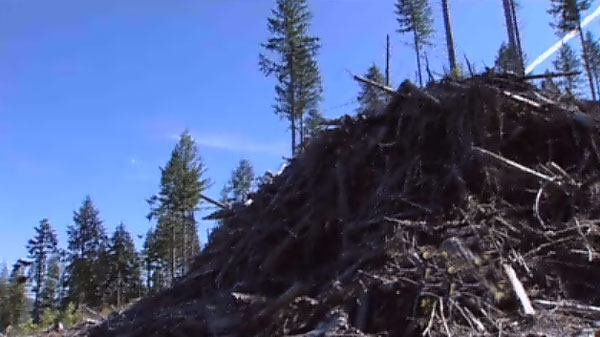Sea-Tac Airport - U.S. Agriculture Secretary Tom Vilseck came calling to Sea-Tac airport this morning, and it wasn't to hop on a flight.
He came to hand out $80 million in grants, $40 million to be administered by the University of Washington and another $40 million handled by Washington State University.
The mission is to find out if a practical, sustainable bio fuel industry based on wood waste can be created in Washington, much of the fuel to flow directly to Sea-Tac Airport for use in jets.
The real issue is finding a way to make these things economically feasible, says Normal Lewis, one of the leaders of thefive year grant at WSU.
Each university is leading a consortium of other schools and even private companies, including Weyerhauser and Colorado-based Gevo, to find a wayover the hurdles thatmay continue to block wood as an alternative fuel source.
For generations, laboratories and manufacturers have converted components of trees into chemical compounds.Someends up in our food, because trees are one source of artificial vanilla.Making fuel out of trees isn't the problem,buildinga sustainableindustry is the challenge these universities need to figure out.
This is an opportunity to take woody biomass...and create a fuel that will allow our jets to fly anywhere in the world. saysAgriculture SecretaryVilsack.
On the west side of the state, much of that woody biomass would come from slash piles left over from logging operations. Not that many years ago, slash piles were burned, which of course put carbon into the air. Now the debris is raked into piles 15 to 20 feet high, where it eventually rots. Piling up the debris allowsfor the planting of seedlings on logged land.
On the state's east side, dry woody debris has built up on the forest floor over generations of fire supression, which has the effect of making forest fires worse when its ignited.The U.S. Forest Service lab in Wenatchee has been studying for years how ponderosa pine and other species that survived more natural fire cycles are killed by these more intense fires. The massive fire storms of 1994 just one example. Massive stands of timber killed by bugs are another source of biomass.
With fuel reduction treatment, we're able to pull some of the dead and dying trees out of the forest, they can be made into jet fuel, making the forest more resilient. says Rachael Jamison, the Department of Natural Resources Energy and Climate Specialist. DNR is getting closer to releasing a study that attempts to assess just how much biomass is available.
There are two ways to remove that downed material. - controlled burning can only be carried out in narrow weather windows when conditions are just right or expensive mechanized removal. it's this mechanized plan could not pay for itself if the fuel plan pans out.
The University of Washington willtestrapidly growing poplar trees as a crop for biomass. The U.W. consortium will create refineries.
WSU will also look at rural communities, which could benefit from biofuels if shuttered saw mills are closed or their towns become sites for biofuel refineries.
The Obama administration is pushing the grants as jobs creators, Secretary Vilsack citing one study claiming 23-thousand jobs could come from the biofuel initiative in Washington alone. The Department of Agriculture is also providing grant money to Louisiana and Tennessee for programs using their native plants to create fuel.


